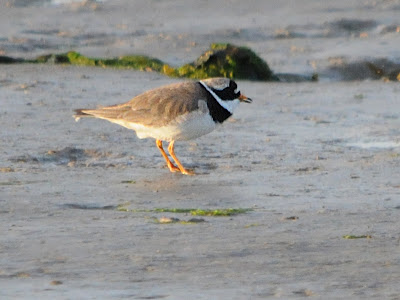I grew up in Hastings, and Rye Harbour was the place where I saw my 'firsts' of many species. My parents didn't drive, so we were limited in where we could get to, but Rye Harbour was reachable via a train ride and a bus ride (or, occasionally, a train ride and a very long walk). On Sunday, I convinced Rob that it would be a good idea for us to go there after aikido, and for him to then drop me off in Hastings to visit my dad. It was another glorious day and he didn't take much persuading.
We arrived just before 4pm - nowhere near enough daylight left to explore the whole of this huge reserve. Instead we walked a short loop around the beach reserve, a swathe of unspoilt and well-vegetated shingle with assorted lakes.
A medley of Med Gulls. The gorgeous Mediterranean Gull has bred at Rye for some years now, among the long-standing Black-headed Gull colony, and today there were hundreds of them here. Easy to pick up in flight with their white wings and quizzical Frankie Howerd-esque call, they were commuting between their nests on the Ternery Pool and some smaller and shallower pools nearby where they were loafing and bathing.
Another unmistakeably loud little beauty - Sandwich Tern. Rye is a bit of a tern mecca, though its real speciality - Little Tern - doesn't breed here every year and is not very numerous. Lots of Sandwiches though.
Another recent colonist here is Avocet, taking the place by storm as it is doing up and down the country. We watched a pair on a small pool near Ternery Pool - they were showing distinct signs of friskiness, as well as ferocious territorial aggression towards a hapless Redshank.
Another species that was very much in evidence, both in the air and on the deck, was Oystercatcher. This species nests on the undisturbed (and protected against ground predators by electric fencing) shingle. We saw loads, including many flocks of a dozen birds doing their piping display.
This weird-looking beast is a Curlew, the only one we saw, flying off a new scrape opposite the Ternery Pool. This scrape also sheltered Avocets, Redshanks and Common and Sandwich Terns.
From the hide at the eastern end of Ternery Pool, you can enjoy great views of the nesting Black-headed Gulls as they go about their daily business of feeding, nest-building, copulating, fighting, bathing and snoozing. The noise is unbelievable.
After our look at the Ternery Pool, we went to the beach, which was very quiet (human-wise) and looked like this.
We sat near the sea and waited to see what came along. What came along included some feeding Common Terns, who provided a stern test of photographic skill/luck, as they energetically fished in the shallows.
We swapped lenses before continuing our walk as Rob wanted a play with the 300mm (but WITHOUT the new teleconverter - is he mad?), which left me to get reaquainted with my old frenemy, the 150-500mm 'Bigmos'.
Those extra 80mm helped bring these distant Golden Plovers (part of a large flock resting on the shingle near the Wader hide) a tiny bit closer.
Another plover - one of several Ringed Plovers on the muddy bank of the river Brede, that separates Rye Harbour from Camber Sands (and East Sussex from Kent). We only went to look at the river because I thought I'd seen a Kingfisher zipping along it towards the sea.
Small birds were not much in evidence today. The main path is usually a good bet for Wheatear at this time of year but we made do with a handful of Linnets.
Light from the hide overlooking the shallow Wader Pool was all wrong. Or was it? The Shelduck looks nice, at least, though a little soft. Out in the worst-lit bit was a solitary Bar-tailed Godwit, creating a nice moody silhouette.
On the last stretch of path I heard yet more Oyks piping overhead, and nearly ignored them, but since the calls were coming from a direction where the light should be good I did swing the Bigmos around and found myself looking at something completely different. A wonderful juvenile-plumaged Peregrine powered by, looking magnificent in the low sunlight.
We left the car park at 7.30pm, when the sun was almost gone. It had been the most fantastic afternoon. Rob took me to my dad's and left me there. He took my camera too (at my request) - I had cause to regret this later when that very night I found a Twenty-plume moth on my dad's kitchen window. On Tuesday morning I had another 'damn, no camera' moment when I spotted a Raven riding a thermal right over dad's house, being mobbed by a Herring Gull.
Subscribe to:
Post Comments (Atom)
























3 comments:
Hi Marianne. Super post, a bit raunchy in places though :-). Love the in flight shots, especially of the feeding Common Terns, and the Peregrine. Great stuff!
Hi
Great Blog post and super photos. I will be back later to take a longer look at some of the posts you've made.
Andrew
A most enjoyable post Marianne with lots of goodies! Living in such a land-locked area I very rarely see many of the birds you show here. I have never seen an Avocet but have always wanted to especially with it having featured as the emblem of the RSPB for so long. Lovely photos and also on your last post which I was sure I had commented on!! I too have the Sigma 150-500mm lens but find it just too heavy and don't fancy taking a tripod out with me, consequently I rarely use it.
Post a Comment